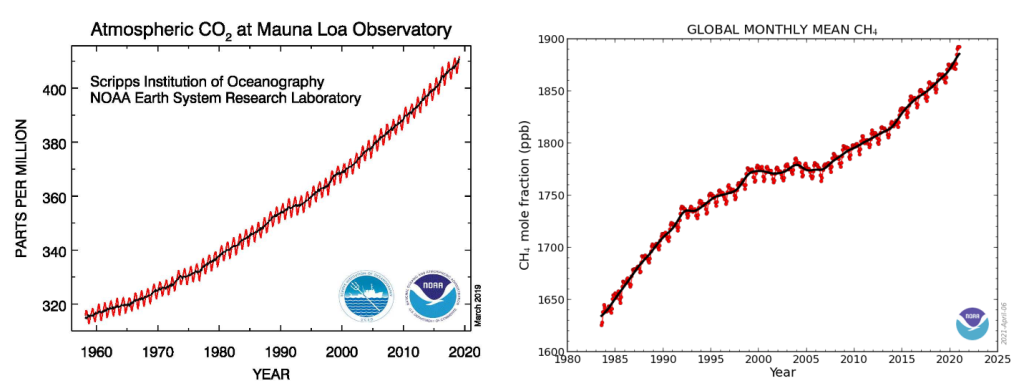1.5 Atmospheric Composition
The Atmosphere

The atmosphere is a cloud of gas and suspended solids extending from the Earth’s surface out many thousands of miles, becoming increasingly thinner with distance but always held by the Earth’s gravitational pull. The atmosphere is relatively thin compared to the Earth. An analogy would be the atmosphere is like the skin on an apple. The atmosphere can be seen from this International Space Station picture taken over the Middle East. The light blue (called airglow) shown on the edge of the Earth is the atmosphere. The airglow is caused by light interacting with the atmosphere.
The atmosphere surrounds the Earth and holds the air needed for life on our planet. It protects this life from outer space; and holds moisture (clouds), gases, and tiny particles. In short, the atmosphere is a protective bubble over Earth.
Gases Comprising Atmosphere
The gases comprising the atmosphere can be divided into two categories: permanent and variable. The permanent gases are the most abundant and are relatively constant over time. The permanent gases and their volumes in a dry atmosphere are listed in this table.
| Gas | Percentage of volume | Molecular symbol |
|---|---|---|
| Nitrogen | 78.08% | N2 |
| Oxygen | 20.95% | O2 |
| Argon | 0.924% | Ar |
| Neon | 0.018% | Ne |
| Other permanent gases | less than 0.009% |
Notice that when added together, the two largest permanent gases comprise over 99% of the atmosphere. Nitrogen is the most prevalent gas. Other than oxygen, the permanent gases generally do not interact with the Earth nor each other and change little over time.
Since most of the atmosphere is “taken” with permanent gases, the remaining portion available for variable gases is small. The variable gases are listed in the table below.
| Gas | Percentage of volume | Molecular symbol |
|---|---|---|
| Water vapor | up to 4% | H2O |
| Carbon dioxide | 0.039% | CO2 |
| Ozone | 0.0015% | O3 |
| Methane | 0.00017% | CH4 |
While these gases are a small percentage of the atmosphere, they play an important role in keeping the planet warm. All these gases capture heat and are also called greenhouse gases. The variable gases are continually interacting with Earth’s surface, and do not stay in the atmosphere long. The average residence time in the atmosphere is about 100 years.
Water vapor (water in a gas state) is nearly always present and can vary from near 0% up to about 4% of the total volume. In the Earth’s deserts, the water vapor contribution to the composition of the atmosphere will be near zero. Water vapor contribution climbs to near 3% on extremely hot/humid days. The upper limit, approaching 4%, is found in tropical climates. As water vapor increases, the percentage of permanent gases decreases. Water vapor is extremely important in weather and will be examined in more detail.
Carbon dioxide is a critical component in plant growth (photosynthesis) and has been increasing in the atmosphere for years. Much of this increase is from human-caused activities (anthropogenic) associated with combustion. An observatory at Mauna, Loa Hawaii has been measuring CO2 since 1959.

Methane, also known as natural gas, has been steadily increasing in the atmosphere. Most of these increases are anthropogenic in nature, and include activities such as rice cultivation, raising livestock, burning of vegetation, and fossil fuel (oil and coal) extraction. Global measurements of methane concentrations have a graph like carbon dioxide.
Video: GEO101 Mod 1.5 Atmospheric composition (6:43 min.)
This video describes the composition of the atmosphere.

